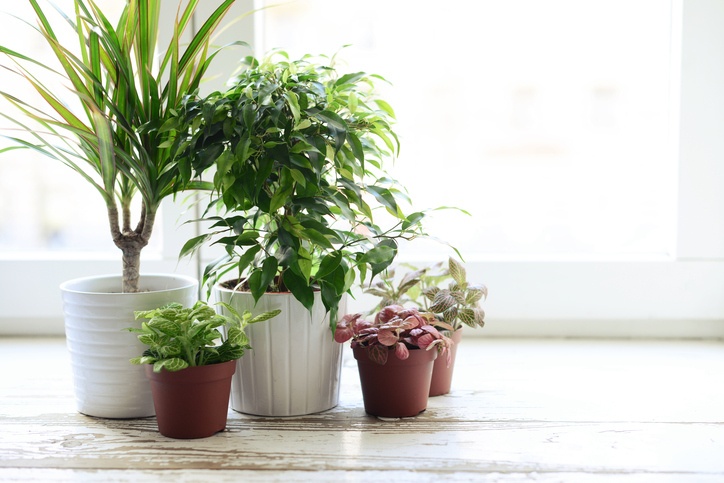
Indoor plants are beautiful additions to any interior, but they do more than add to the aesthetics of your home. They refresh the air by drawing in carbon dioxide and releasing pure oxygen as all green plants everywhere do. Plants also act as natural humidifiers, easing respiratory problems like dry coughs and colds. In addition to that, they absorb certain unwanted or toxic chemicals from the air, effectively removing them from the air we breathe. Several studies have shown that they improve mood and increase productivity in work environments.
It feels good to have something green and growing within our immediate living space. It could be considered a natural extension of our original existence in the lap of nature. While we demarcate the exteriors and the interiors with impermeable walls, bringing a few plants indoors can make all the difference. We already knew from experience that indoor plants lift up our spirits and make us less prone to headaches, mood swings and even allergies. But it took certain experiments by NASA in controlled conditions to tell us exactly why.
They tested a number of common houseplants against indoor air pollutants, particularly ammonia and volatile organic compounds (VOCs) like formaldehyde, trichloroethylene, benzene, toluene, and xylene. High levels of VOCs in the indoor air result in several health problems, collectively called ‘sick building syndrome’. Some of them, like benzene, are known carcinogens. Benzene plays a major role in the carcinogenic effect of tobacco smoke. This chemical leaches into the air from plastics, synthetic fibers and resins in the house and cause nausea, vomiting, and dizziness. Formaldehyde emitted by paints and varnishes and the adhesives used in wall boards can irritate the respiratory tract and cause allergies.
Many of the plants tested absorbed at least one or two of the toxic compounds while a few showed the capacity to mop up several of them, if not all. Surprisingly, the best performers are also easy-care plants that are readily available.
1. Peace lily (Spathiphyllum wallisii)
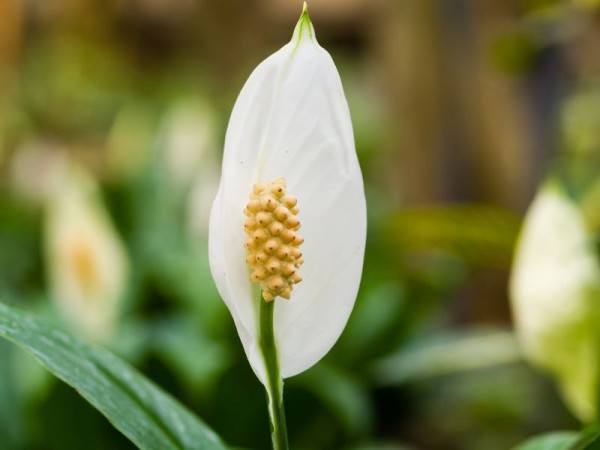
Peace lily tops the list of plants NASA recommends for cleaning the indoor air. The scientists have found that this popular houseplant can reduce the levels of all the five indoor air pollutants tested. Spathiphyllum, with its tuft of shiny, slightly ruffled leaves and white flowers held high above the foliage is one of the few houseplants that bloom reliably even in low light conditions. But it will reward you with continuous flowering if given ample light.
The thick growth of dark green leaves shows off the pristine white flowers to great advantage. The large, white, petal-like portion is a modified leaf called spathe that protects the creamy white, spiky inflorescence. It turns green as it ages. But removing older spathes promotes flowering.
Peace lilies thrive in warmth and humidity, so it is ideal for bathrooms and kitchen. It can withstand temperature variations from 40F to 100F, but does best in 65F to 85F range. Regular watering and feeding ensures lush growth but allows the soil to become nearly dry between subsequent watering.
Propagation is easy. You start with one plant, but end up with a potful soon. You can easily divide the clump to extend your collection to other rooms or share with friends.
2. Chrysanthemum (Chrysanthemum morifolium)
This flowering plant, better known as garden mums or florist’s chrysanthemum is a favorite with almost every gardener. The flowers come in several colors and shapes, but they are floriferous only when grown outdoors in full sun. But they make the list on the strength of their ability to improve indoor air quality. They are at par with peace lily in this regard, removing ammonia as well as all the five toxic VOCs tested.
Ideally, mums should be grown outdoors for the most part and then brought indoors after the buds have developed. That way, the plants will be healthy, and you will get to enjoy the flowers. They can spend the winter indoors in a brightly lit place, where they can continue to clean the air of pollutants. Return them to the garden in spring for the next cycle of flowering.
Feed chrysanthemums regularly and water them when the top layer of soil dries out. Take cuttings or divisions to multiply your collection.
3. English Ivy (Hedera helix)
English ivy has a long history of being used as a houseplant, but it has fallen out of favor of late because of its current status as an invasive weed in most parts of the country. Their beautiful leaves and trailing branches can be better enjoyed indoors, with no fear of the plants taking over the landscape. They are so versatile that you can use them in different ways to enhance your décor. Grow them in hanging pots or trained on trellises.
English ivy likes rich soil with a fair amount of organic matter that helps retain moisture. They need bright light to do well, especially the variegated varieties. Prune them whenever necessary, using the cut branches in flower arrangements or to start new plants. Have as many plants as you can find place for; they mop up the VOC from the indoor air, making it healthier for you. Just avoid throwing them into compost bins or anywhere outdoors where they can be a problem.
4. Mother-in-law’s tongue/Snake plant (Sansevieria trifasciata ‘Laurentii’)
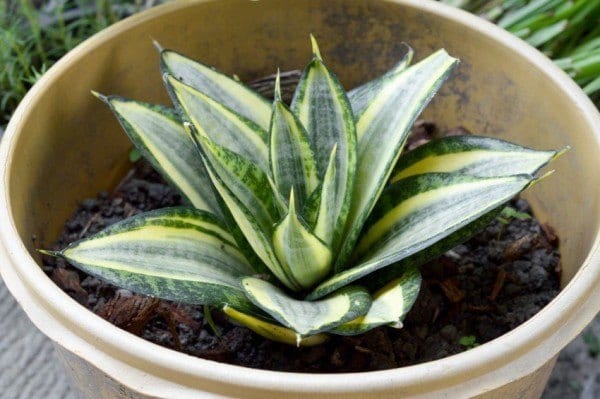
This tough plant is nearly indestructible, its only weak spot being overwatering. You can relegate it to the darkest corner in the attic or basement, but it will survive there for a very long time, unattended and uncared for. However, surviving is not the same as thriving. Give them bright sunlight and regular watering, and they glow with bright variegation and healthy growth.
Sansevieria plants send out new leaves from the creeping rhizomes that remain underground, usually just below the top layer of soil. A loose soil structure helps the plant to spread faster and fill out the pots quickly. No feeding is necessary, but you can use a general fertilizer once or twice a year. They are free of pests and diseases, and the vertical orientation of leaves avoids dust collection.
Propagate snake plant by dividing the rhizomes. You can grow new plants from leaf sections, but the resultant plants sadly lose the bright yellow variegation along the edges. Divisions retain the variegation.
5. Dracaena (Dracaena marginata, D. fragrans ‘Massangeana,’ D. deremensis ‘Janet Craig’ and ‘Warneckei’)
Commonly called dragon tree plants, these are cane-forming plants with a tuft of leaves at the tip of branches. Of the several species and cultivars of dracaenas available, the red-edged dracaena (Dracaena marginata) seems to have come out the winner in NASA experiments, but the other three varieties are not far behind in offering health benefits.
Dracaenas are tough plants that will put up with a lot of neglect, but they will stretch and grow up to the ceiling with the slightest care. Water young plants frequently, but older plants are drought tolerant. Keep the plants under control by pruning the canes whenever necessary. Some people love the architectural shapes they assume as they grow tall with leafless stalks except for the terminal tuft. Others prefer a bushy plant. Pruning promotes branching and a much thicker tuft of leaves. If one grows too lanky, you can take a stem cutting to start a new plant.
You can use either tip cuttings or 6” long midsections of the stem for propagation, the former giving single-stemmed plants with upright growth, while stem sections grow into a multi- branched specimens, unless extra shoots are diligently removed.
6. Gerbera daisy (Gerbera jamesonii)
These flowering plants are known for their beautiful flowers in vibrant colors. Often used as cut flowers, they last in vases for several days. They look equally good on the plants, each one consisting of a rosette of downy, radish-like leaves, with the flowers arising from the middle of the rosette.
Gerbera daisies are usually grown as annuals outdoors except in USDA zones 9 and above. When grown indoors, you can keep them as perennials for 2-3 years, but if you expect to get flowers, provide very bright light. An east-facing window is best because too much afternoon sun can scorch the leaves of plants kept indoors.
Rich, well-draining soil keeps the plants healthy. Regular feeding all through the flowering season is essential, so is deadheading to keep the blooms coming. The plants can be kept on the dry side to reduce the risk of diseases, but water stress should be avoided because frequent wilting weakens the plant and invite diseases.
7. Devil’s ivy (Epipremnum aureum)
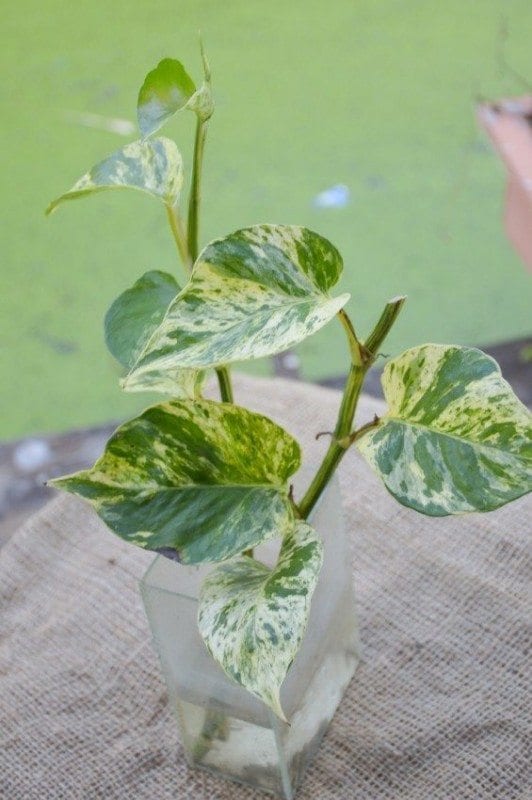
This plant gets its common name from its vigorous growth habit in their native habitat in the tropical rainforests of South America. These fast climbers are known to overwhelm all the trees in their vicinity by climbing to their crowns and blocking sunlight and sending down long, whip-like secondary roots to ensure firm attachment. However, there’s no danger of that happening when they are grown indoors in containers. In fact, that is the only safe way to grow them in warmer areas.
Growing and propagating devil’s ivy is extremely easy. It does not require feeding or regular watering. It adapts well to low light conditions, but the growth may suffer, and the yellow streaks in the ‘Golden Pothos’ variety may be lost, all the leaves turning to solid green. However, it readily regains the bright coloration and vigorous growth when brought back to bright light. Trim the plants frequently to promote bushy growth. You can use each stem tip with 2-3 nodes to start new plants.
8. Broadleaf lady palm (Rhapis excelsa)
It is a fan palm with leaves divided all the way, making it look like a hybrid of palmate and pinnate palms. The growth habit is clumping and cane-forming. You usually get a bushy specimen with slender canes of different heights than a single tall plant as the years go by. Yes, these house plants are long living, and it is worth spending extra on one or two good-sized plants. And they do not like to be disturbed, so it makes sense to start them off in a large pot or tub.
Broadleaf lady palm is happiest when grown outdoors in tropical climates, but adapts well to a wide range of temperature from 20F to 100F. Light requirement is variable. This is one palm that can survive in low light, albeit with sluggish growth, but bright light does it justice. Another advantage is that they do equally well in high humidity and dryness, making them ideal for all kinds of interiors. They don’t need frequent feeding, but regular watering is essential. When grown in tall pots, deep watering is necessary to reach their roots that usually run closer to the bottom of the pots. Water stress can cause brown leaf tips.
Take your lady palms outdoors once in a while to check for scale insects. Divide the clumps to increase your collection, but do it without disturbing the roots too much.
9. Spider plant (Chlorophytum comosum)
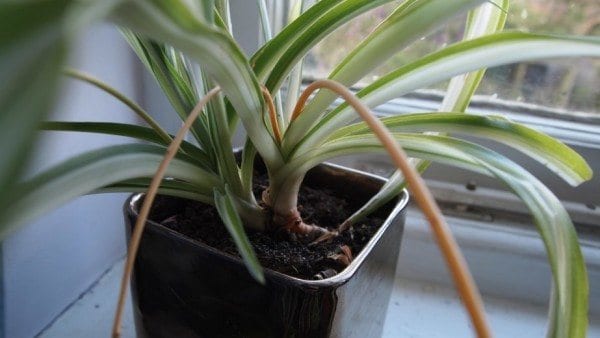
Spider plants are a favorite with children and a common fixture in many schoolrooms. That tells you how easy it is to grow them. They are usually grown in hanging planters to give space for the leaves to spread, but keeping them on a pedestal or a shelf can be just as effective. The grass-like variegated foliage can brighten up any dull corner in your home. If anything can be more interesting than the gracefully arching leaves, it is the flower stalks that shoot up from amidst the leaves. These eventually get weighed down by tiny plantlets that develop at their tips. These plantlets grow roots and get established as soon as they come in contact with soil, but that doesn’t happen with potted plants.
Spider plants are undemanding and low on maintenance. They don’t need pruning or frequent repotting. You can propagate them by dividing existing clumps or potting up the plantlets. Once potted up in well-draining soil, they will live happily for a long time, filling out the pot and overflowing its edges. They like constant moisture in the soil, but not waterlogging. The thick, fleshy roots may rot if there’s excess water. However, this plant can be grown directly in water too, in which case, the roots become acclimatized to the liquid medium. That makes it ideal for people who suffer from soil borne allergies.
Spider plants thrive in moderate light, but may suffer a bit in low light. The leaf variegation may get affected, and the leaf tips may start to brown. Feeding is rarely necessary if grown in a good quality potting mix containing long-release fertilizers.
Help your houseplants thrive
There’s no hard and fast rule about the placement of houseplants, but they do their best when each plant is given an environment closest to its ideal growing environment regarding temperature, humidity, and light. Like plants growing outside in the garden, houseplants love company. You can group those with similar cultural requirements together in larger containers to form pleasing arrangements.
Soil microbes in the pots do have a role in keeping the indoor air clean and healthy, but some people may develop allergies. Soil molds could be the main culprits. They can be controlled by limiting water and allowing good drainage and air circulation. Growing the houseplants in soilless media, or hydroponically, is another option.
So, if you are looking for a healthy addition to your home, consider one of these beautiful and low-maintenance, NASA approved houseplants and enjoy cleaner air and a more vibrant home.
